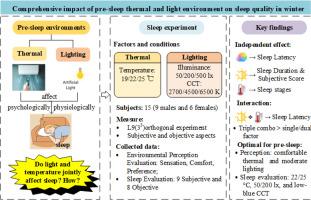Comprehensive impact of pre-sleep thermal and light environment on sleep quality in winter
IF 7.6
1区 工程技术
Q1 CONSTRUCTION & BUILDING TECHNOLOGY
引用次数: 0
Abstract
Both pre-sleep thermal and lighting environments influence sleep quality through psychological and physiological pathways, with interconnected mechanisms. Despite this interdependence, limited research has systematically examined their combined effects. To address this gap, a three-factor, three-level orthogonal experiment was conducted. The environmental factors investigated were pre-sleep temperature (19 °C, 22 °C, 25 °C), illuminance (50 lx, 200 lx, 500 lx), and correlated color temperature (CCT) (2700 K, 4500 K, 6500 K). Subjective evaluations and objective measurements (wrist-worn accelerometer) were combined to assess sleep quality. During the experiment, a total of 184 sleep records were collected from 15 subjects (9 males and 6 females). The collected data were analyzed using ANOVA and other methods. The results showed that among the three environmental factors, CCT predominantly influences sleep latency, while illuminance primarily governs both sleep duration and subjective sleep quality assessment. Temperature exhibits the most pronounced effect on sleep stages. Our findings further reveal that establishing a comfortable thermal and moderately satisfying lighting pre-sleep environment can reduce sleep latency, wakefulness, and light sleep, and increase REM sleep, deep sleep, and sleep duration. Crucially, the synergistic interaction of temperature, light, and CCT surpass single or dual factor effects on sleep. Notably, CCT's independent effect on sleep latency exceeds its interaction with either temperature or illuminance; the interaction between temperature and illuminance on sleep latency is significant, but their independent effects are small. Finally, this study indicates that a neutral (22 °C) or slightly warm (25 °C) temperature and low (50 lx) or moderate (200 lx) illuminance are suitable for pre-sleep, and the appropriate CCT should consider the impact of blue light. This research provides a theoretical basis for the creation of comfortable thermal and lighting environments for sleep.

冬季睡眠前热、光环境对睡眠质量的综合影响
睡眠前的热环境和光照环境都通过心理和生理途径影响睡眠质量,并具有相互关联的机制。尽管存在这种相互依赖,但有限的研究系统地考察了它们的综合影响。为了解决这一差距,进行了三因素三水平正交试验。环境因素包括睡眠前温度(19°C、22°C、25°C)、照度(50 lx、200 lx、500 lx)和相关色温(2700 K、4500 K、6500 K)。主观评估和客观测量(腕带加速度计)相结合来评估睡眠质量。实验过程中,共收集了15名被试(男9名,女6名)的184份睡眠记录。收集的数据采用方差分析等方法进行分析。结果表明,在三个环境因素中,CCT主要影响睡眠潜伏期,而照度主要影响睡眠持续时间和主观睡眠质量评价。温度对睡眠阶段的影响最为显著。我们的研究结果进一步表明,建立舒适的热环境和适度满意的睡眠前照明环境可以减少睡眠潜伏期、觉醒和浅睡眠,并增加快速眼动睡眠、深度睡眠和睡眠时间。至关重要的是,温度、光线和CCT的协同作用超过了单因素或双因素对睡眠的影响。值得注意的是,CCT对睡眠潜伏期的独立影响超过了它与温度或光照的相互作用;温度和照度对睡眠潜伏期的交互作用显著,但独立影响较小。最后,本研究表明,中性(22°C)或稍暖(25°C)的温度和低(50 lx)或中等(200 lx)的照度适合睡眠前,适当的CCT应考虑蓝光的影响。本研究为营造舒适的睡眠热、光环境提供了理论依据。
本文章由计算机程序翻译,如有差异,请以英文原文为准。
求助全文
约1分钟内获得全文
求助全文
来源期刊

Building and Environment
工程技术-工程:环境
CiteScore
12.50
自引率
23.00%
发文量
1130
审稿时长
27 days
期刊介绍:
Building and Environment, an international journal, is dedicated to publishing original research papers, comprehensive review articles, editorials, and short communications in the fields of building science, urban physics, and human interaction with the indoor and outdoor built environment. The journal emphasizes innovative technologies and knowledge verified through measurement and analysis. It covers environmental performance across various spatial scales, from cities and communities to buildings and systems, fostering collaborative, multi-disciplinary research with broader significance.
 求助内容:
求助内容: 应助结果提醒方式:
应助结果提醒方式:


